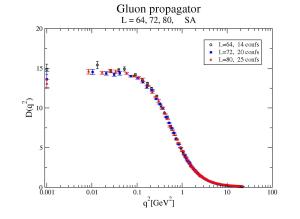We have seen here that the gluon propagator can be fitted with a Yukawa form that gives a mass gap . The pure number 1.25 fixes the ground state of the theory. Higher excited states in the spectrum will be characterized by a greater pure number multiplying the QCD constant of 440 MeV. The question we ask here is: Are there other lattice computations supporting this view? We show here that this is indeed the case.
As already pointed out, the spectrum in D=3+1 for Yang-Mills theory, also claimed to be a glueball spectrum, has been computed by Teper et al. and Morningstar et al. But these computations generally give the first few states for each kind of resonance. So to say, one has just and
and this may not be too convincing. But there is a paper on arxiv due to Harvey Meyer, that worked with Teper’s Group in Cambridge, that extends the computations further (see here). This is unpublished material being a PhD thesis.
We can sum up the pure numbers obtained by Meyer for the case with the relative error:
Now we assume that this spectrum has the simple form of an harmonic oscillator, that is we take . Our aim will be to obtain
in close agreement with computations for the gluon propagator. We obtain the following table
There is a lot to say about this result. It is striking indeed! We get practically the same as the one obtained from lattice computations of the gluon propagator that, as said above was 1.25, if we consider that the error increases with
. But what is more, one can extrapolate the above results to
obtaining the proper ground state of the theory again recognizing the
resonance. We just note that if we use the improved values 3.55(7) and 5.69(10) by Teper et al. (see here) we get a still better agreement obtaining 1.183 with an error of 0.023 and 1.14 and error of 0.05, making
very near the value 1.19 that we claimed would give an improved spectrum in AdS/CFT computations (see here).
This computation makes clear a point. Present lattice computations of the glueball spectrum are not fully satisfactory for D=3+1 as they do not seem to hit the right ground state of the theory as is done by lattice computations for the propagators. I think some improvement is needed here for a better understanding of the situation.
We will have more to say about Yang-Mills spectrum in future posts.





 Posted by mfrasca
Posted by mfrasca 






